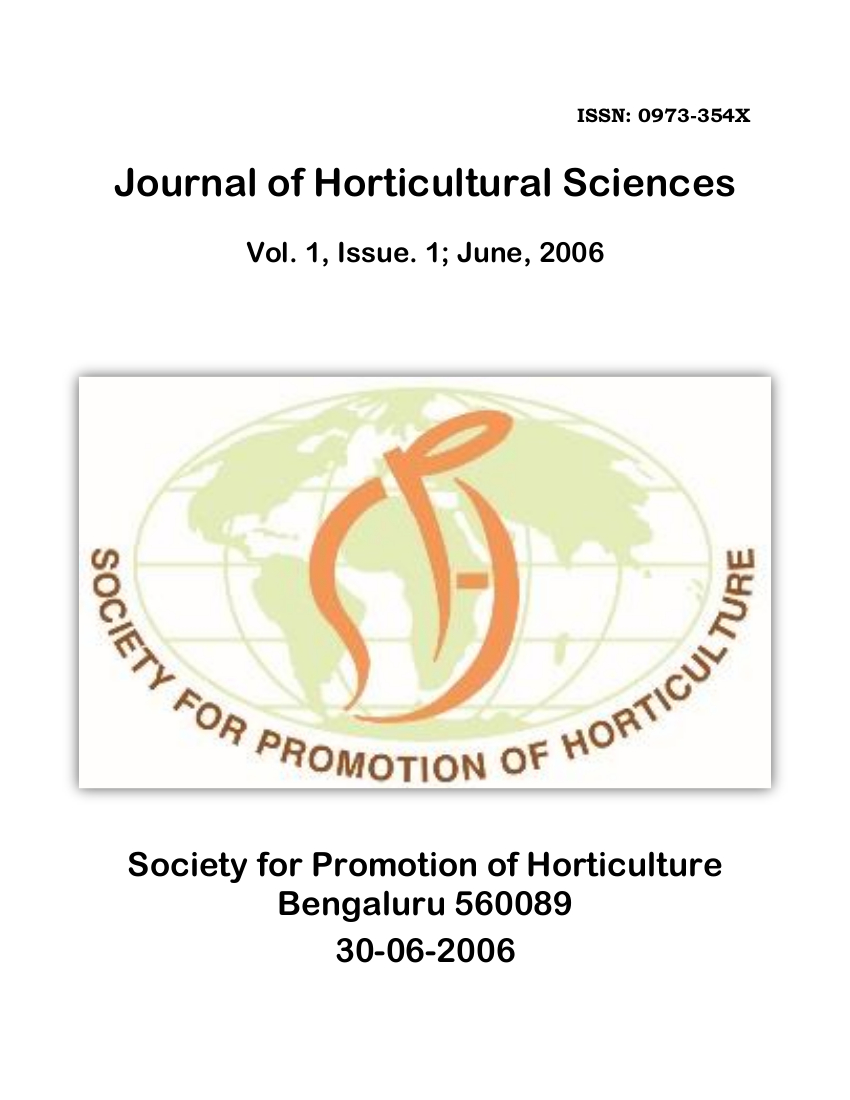Development of IPM Package with Safe Pesticide Residue: 1. Cabbage
DOI:
https://doi.org/10.24154/jhs.v1i1.670Keywords:
Cabbage, Biological Control, IPM, Pesticide ResiduesAbstract
An IPM module with safe pesticide residues on cabbage, with already proven treatments such as carbosulfan, dimethoate, cypermethrin + profenofos and mancozeb under chemical method of control; NSP, Bacillus thuringiensis and Trichogramma bactrae under non chemical method of control were revalidated individually and in combination. Six releases of parasitoid T. bactrae at weekly intervals starting from 12 days after transplanting or spray of NSP 4% at 10-15 days interval, 4 times, starting from 20 days after transplanting, foliar spray of dimethoate and mancozeb gave good control of aphids, leaf blight and black rot respectively. Based on the effectiveness of the treatment and pesticide residues below their permissible levels in cabbage at harvest, a module was developed and tested in the field. The IPM package thus developed was found to control the pests effectively and at the same time the residues on the crop were within the safe limits.
Downloads
References
Anonymous, 1984. Indian Standard Method for determination of dimethoate residues in food commodities. IS: 11021-1984.
Anonymous, 2001. IIHR Annual Report, 2000-2001, p 83, IIHR, Hessaraghatta, Bangalore, India
Agnihotri, N.P. 1999. Pesticide safety evaluation and monitoring. AICRP on Pesticide Residues, Division of Agricultural Chemicals, lARI, New Delhi, 173p.
Babu,T.R., Sultan, M.A., Reddy.K.N., Reddy, D.J. 2001. Dissipation of quinalphos and cypermethrin residues in cabbage. Indian J PI Prot., 29:144-145.
Becker, R.F. 1989. Cultural practices and cultivar selection as the foundation of a cabbage IPM program. Trans.Illinois State Hortil. Soc, 123:28-31.
Brown, J.D. and Hargreaves, J.R. 1979. Control of cabbage pests. Queensland Agril J., 105:222-228.
Chen, Y.J., Lu, Y.H., Zhang J., Liu J and Wen X.M. 2001. Extraction and analysis of profenofos residue in tomato and cabbage by gas chromatography -flamephotometric detector. Se Pu, 19:283-5.
Finch,S. 1993. Integrated pest management of the cabbage root fly and the carrot fly. Crop Prot., 12:423-430.
Floru, S. and Isac, M.1974. Persistence of dimethote residues in fruits and vegetables. Analele Institutului de Cercertari pentru Protectia Plantelor, 19:487-490.
Jayakumar, R., Habeebullah, B and Regupathy, A. 1995. Evaluation of mancozeb residues in tomato. Pestic. ResJ.,7:Sl-8S.
Keppel, G.E. 1971. Collaborative study of the determination of dithiocarbamate residues by a modified carbon disulfide evolution method. /. Assoc Offic Anal Chem., 54:528-532.
Krishnaiah, K., Mohan N.J. and Prasad, V.G. 1981.Efficacy of Bacillus thuringeiensis Ber for the control of lepidopterous pests of vegetable crops. Entomon. 6:87-93.
Krishnamoorthy, A., Rama, N., Mani, M., Pattar, G.L. 2003. Biological control of diamond back moth, Plutella xylostella (Linnaeus) in cabbage, integrating egg parasitoid, Trichogrammatoidea bactrae Nagaraja with trap crop. 2003. In : Biological control of lepidopteran pests-Proc. Sym. Biol. Cont. Lepidopteran Pests, July, 17-18, 2002, p. 275.
Krishna Moorthy, P.N. and Krishna Kumar, N.K. 2000. Efficacy of neem seed kernel powder extracts on cabbage pests. Pest Manag Hortil. Ecosys., 6:27-31.
Krishna Moorthy, PN. and Krishna Kumar, N.K. 2001. IPM in crucifer, legume and cucurbit vegetables. In : P.Parvatha Reddy, Abraham Verghese and N.K.Krishna Kumar (eds.). Integr Pest Manag. Hortil. Ecosys. Capital Publishers, New Delhi, pp. 81-92.
Leppert, B.C., James, CM., Robert, C.H. and Glenn,H.F. 1983. Determination of carbosulfan and carbofuran residues in plants, soil and water by gas chromatography. J. Agric. Food Chem., 31:220-223.
Mallapur, C.P, Bhat, N.S. and Lingappa, S. 1994.Control of cabbage pests by insecticides. J Maharashtra Agril. Univ., 19:259-261.
Mohan, N.J. 1987. Evaluation of new insecticides for the control of cabbage pests. Pesticides, 21:49-54.
Pollard, GV. 1991. Constraints to IPM development and a strategy for management of tomato and cabbage pests in Trinidad, West Indies. Trop Pest Manag., 37:59-62.
Rajeswaran, J., Merlinkamala, I., Chandrasekharan, S., Jayakumar, R. and Kuttalam, S. 2004. Harvest time residues of carbosulfan in brinjal fruits. / Fd. Agric. Environ., 1:216-211.
Saucke, H. 1994. Selective bioinsecticides selective chemical insecticides: Important options for integrated pest management (IPM) in cabbage. Harvest-Port Moresby, 16:16-19.
Setiawati, W. 2000. Controlling of diamondbackmoth (Pleutella xylostella L) and cabbage head caterpillar {Crocidolomia totalis Zell) by using Spinosad 25 SC and its effect on parasitoid Diadegma semiclausum Hellen. Jurnal Hortikultura (Indonesia), 19:30-39.
Singh, K.J., Jalali, S.K., Rabindra, J.R., Rao, N.S. and Lalitha, Y. 2004. Role of egg parasitoid, Trichogra-mmatoidea bactrae Nagaraja alone and in combination with dichlorovos in the management of Plutella xylostella (L.) on cabbage. / Biol Cont., 18:135-139.
Smith, R.M., Madahar, K.C., Salt W.G. and Smart, N.A. 1982. Degradation of ethylene thiourea on lettuce. Pestic. Sci., 23:337-349.
Srinivasan, K. and Krishna Moorthy, RN. 1991. Mustard plants trap major cabbage pests. Indian Farming, 40:11-12.
Srinivasan, K. and Krishna Moorthy, RN. 1993. Evaluation of neem products and other standard chemicals for the management of major pest complex on cabbage: Comparison between standard spray regime and IPM involving mustard as a trap crop. In: Neem and Enviornment, Vol.1, (eds.) R.R Singh, M.S.Chari, A.K. Raheja, and W.Kraus. Oxford and IBH Publishing Co. (Pvt.) Ltd., New Delhi and Calcutta, pp. 447-458.
Telebi, K. and Ghassami, M.R. 2004. Residues of Profenfos in spring onion. Commun. Agric. Appl Biol. Sci., 69:799-802.
Wheeler, B.E.J. 1969. An introduction to plant disease. John Wiley, London, U.K., 301 pp
Downloads
Published
Issue
Section
License
Copyright (c) 2006 Debi Sharma, A Krishnamoorthy, P N Krishna Moorthy, Girija Ganesan, A K Ahuja, M D Awasthi (Author)

This work is licensed under a Creative Commons Attribution-NonCommercial-ShareAlike 4.0 International License.
Authors retain copyright. Articles published are made available as open access articles, distributed under the terms of the Creative Commons Attribution-NonCommercial-ShareAlike 4.0 International License, which permits unrestricted non-commercial use, distribution, and reproduction in any medium, provided the original author and source are credited. 
This journal permits and encourages authors to share their submitted versions (preprints), accepted versions (postprints) and/or published versions (publisher versions) freely under the CC BY-NC-SA 4.0 license while providing bibliographic details that credit, if applicable.












 .
. 













